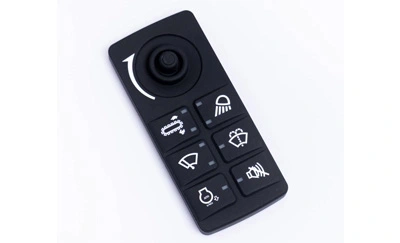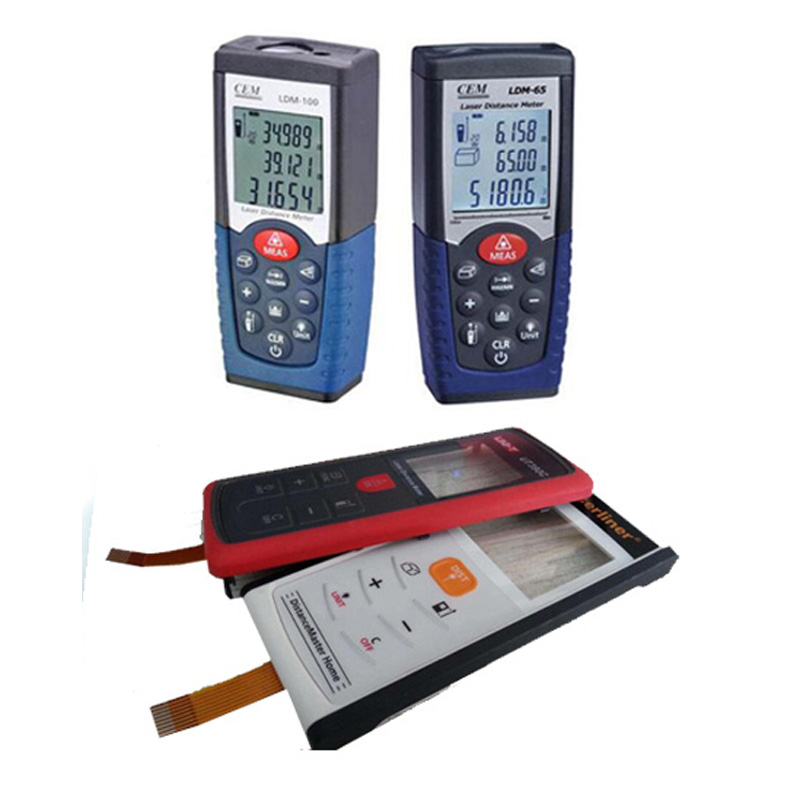The rise of membrane switch in aerospace applications
Wiki Article
All About Membrane layer Change: A Comprehensive Overview for Beginners
Membrane buttons are crucial components in contemporary electronics, offering a special interface for individual communication - membrane switch. Their layered building and construction, including overlays and conductive traces, supplies functionality and toughness. Unlike standard mechanical buttons, membrane switches offer a sleek style and personalized options. Comprehending their vital features and benefits can change product style. Nonetheless, the complexities of their application and style factors to consider warrant additional expeditionWhat Is a Membrane layer Switch over?
A membrane button is a kind of electrical switch that includes a versatile membrane layered over a printed circuit card. This style permits a small and smooth interface, commonly made use of in numerous electronic tools. Membrane switches are frequently discovered in consumer home appliances, clinical tools, and industrial machinery because of their longevity and resistance to ecological factors.The building and construction commonly consists of numerous layers, such as visuals overlays and sticky backing, which provide tactile responses and shield the wiring beneath. The operation of a membrane button is launched when pressure is applied to the surface area, finishing an electrical circuit.These switches are valued for their convenience, making it possible for custom-made styles and printed graphics that provide to certain individual interfaces. Their low-profile nature lowers area needs, making them suitable for applications where standard switches might not fit. In general, membrane layer buttons offer a aesthetic and functional option for contemporary digital gadgets.Trick Parts of Membrane Changes
Membrane switches make up numerous crucial components that contribute to their performance and efficiency. The leading layer, called the overlay, offers the customer interface and is typically printed with graphics or signs. Under the overlay exists a spacer layer, which separates the conductive aspects and avoids unintended activation. The following vital component is the visuals layer, which improves looks and assures the resilience of the design.Conductive traces, usually made from products like silver or carbon, are published on the circuit layer. When pressure is related to the overlay, these traces enter call, completing the circuit. Furthermore, a support layer provides architectural support and can be made from products such as polyester or polycarbonate. With each other, these parts produce a reliable, straightforward user interface ideal for different applications, from family appliances to industrial equipment. Understanding these aspects is essential for anyone thinking about membrane layer button innovation.Just How Membrane Layer Switches Over Job
Recognizing just how membrane switches function is essential for appreciating their widespread usage in numerous tools. A membrane layer button operates through a series of layers, consisting of a visuals overlay, spacer, and a circuit layer. When stress is related to the overlay, it compresses the spacer layer, enabling the circuit layer to make contact and finish an electric circuit. This activity sends a signal to the device, motivating a feedback, such as activating a light or turning on a function.Membrane changes can be developed with various attributes, consisting of tactile feedback, backlighting, and custom graphics, boosting customer interaction. Their construction enables a closed design, protecting the inner elements from dirt, moisture, and contaminants. This longevity makes them appropriate for varied applications, from consumer electronic devices to industrial tools. Generally, the simpleness and effectiveness of membrane changes add to their appeal in modern-day innovation.Advantages of Membrane Layer Switches Mechanical Buttons
While mechanical switches have actually long been a staple in many gadgets, membrane changes deal unique benefits that make them increasingly appealing. One substantial benefit is their slim account, enabling more portable designs and higher adaptability in product advancement. In addition, membrane changes attribute an uniform surface, which boosts aesthetic charm and streamlines cleansing, making them suitable for atmospheres where health is critical.Another benefit is their resistance to dust and wetness. Unlike mechanical buttons, which can be endangered by environmental elements, membrane layer buttons provide a closed user interface that shields versus contaminants - membrane switch. Additionally, membrane layer buttons usually have a longer life-span as a result of less relocating components, causing enhanced sturdiness and reliability.Cost-effectiveness is also a notable benefit, as membrane layer buttons can be generated wholesale with reduced production prices. These elements combine to position membrane layer switches as a useful alternative to traditional mechanical options in numerous applicationsUsual Applications of Membrane Switches
Membrane layer buttons are extensively utilized in various sectors, specifically in customer electronics and industrial control panels. In consumer devices, they give a streamlined, easy to use interface, while in commercial settings, they boost longevity learn the facts here now and capability. Comprehending these applications highlights the versatility and usefulness of membrane layer buttons in modern-day technology.Consumer Electronic Devices Instruments
As customer electronics remain to develop, membrane buttons have actually come to be a preferred option for a range of devices due to their adaptability and smooth design. These switches are generally located in mobile phones, tablets, and remotes, where space is restricted and aesthetic appeals matter. Their low profile and customizable designs allow makers to develop easy to use user interfaces that enhance the total customer experience. Furthermore, membrane switches are frequently used in home appliances such as microwaves and coffee machine, supplying user-friendly control choices while withstanding dampness and dust. The sturdiness and integrity of membrane layer switches make them appropriate for everyday customer items, making sure long life and regular efficiency. On the whole, their assimilation in consumer electronics shows a mix of performance and contemporary design.Industrial Control Panels
The applications of membrane switches over extend beyond consumer electronics, locating significant usage in industrial control board. These buttons are preferred for their toughness and resistance to severe atmospheres, making them ideal for producing and procedure control settings. They provide a trusted user interface for operators to manage equipment, monitor processes, and adjust settings. Membrane buttons can be customized to match specific functional demands, integrating functions like backlighting and responsive comments, enhancing customer experience. Their low-profile style permits assimilation right into different equipment, while their capacity to hold up against spills, dust, and extreme temperature levels assurances longevity. On the whole, membrane buttons add to reliable and secure procedure in commercial applications, demonstrating their flexibility and performance popular settings.Factors To Consider for Creating Membrane Switches
When creating membrane layer switches, selecting the ideal materials is necessary to guarantee resilience and performance. In addition, recognizing layer configuration methods can substantially impact the switch's performance and individual experience. These considerations play an essential role in developing reliable and dependable membrane layer switch designs.
Product Selection Significance
Product option plays a vital role in the layout and capability of membrane buttons. The selected materials straight impact the button's resilience, tactile feedback, and overall visual. Secret factors to consider consist of the substratum, which need to supply architectural integrity while enabling flexibility, and the visuals overlay, which needs to be immune to wear and ecological aspects. Conductive materials need to assure trusted electrical performance, while adhesives should use strong bonding without jeopardizing the button's procedure. Furthermore, compatibility with producing processes and end-user settings is important; products must withstand varying temperatures, moisture levels, and chemical like it exposure. Ultimately, suitable product option not just boosts the membrane button's performance but also adds to its durability and individual complete satisfaction, making it a critical aspect of the layout process.
Layer Configuration Methods

Often Asked Questions
How Much Time Do Membrane Layer Switches Generally Last?
Membrane switches usually have a life-span of 1 to 5 million cycles, depending on usage and environmental conditions. Elements such as layout high quality and operating regularity significantly affect their durability and total performance longevity.
Can Membrane Layer Switches Over Be Custom-made for Specific Styles?
Membrane switches can without a doubt be tailored to accommodate particular layouts, enabling diverse shapes, colors, and capabilities. This flexibility allows producers to tailor these buttons to meet special visual and operational needs effectively.What Products Are Made Use Of in Membrane Layer Switch Building?
Membrane switches are commonly constructed making use of materials such as polyester, polycarbonate, and glue layers. These materials offer flexibility, resistance, and resilience to ecological factors, guaranteeing the buttons work effectively in numerous applications and conditions.
Are Membrane Layer Changes Resistant or waterproof to Wetness?
Membrane switches can be developed to be moisture-resistant, making use of specialized materials and layers. Their water resistant capacities depend on building and construction high quality and certain applications, making it essential to analyze needs for ideal performance in different settings.Exactly How Are Membrane Layer Switches Repaired if Harmed?
Repairing damaged membrane layer switches normally involves changing the influenced layer or circuit. Professionals may likewise apply conductive adhesive or make use of specialized fixing sets, ensuring performance is restored without complete replacement of the entire button assembly. Unlike standard mechanical buttons, membrane layer buttons present a smooth design and adjustable choices. A membrane layer button is a type of electric button that consists of an adaptable membrane layer layered over a printed circuit board. The operation of a membrane layer switch is initiated when stress is applied to the surface area, completing an electrical circuit.These switches are valued for their flexibility, allowing custom-made styles and printed graphics that cater to specific customer interfaces. While mechanical switches have actually long been a staple in lots of devices, membrane switches offer distinct benefits that make them increasingly appealing. here are the findings Membrane layer switches commonly have a longer life expectancy due to fewer moving parts, resulting in improved longevity and reliability.Cost-effectiveness is also a noteworthy advantage, as membrane layer buttons can be created in mass with lower production expenses.Report this wiki page